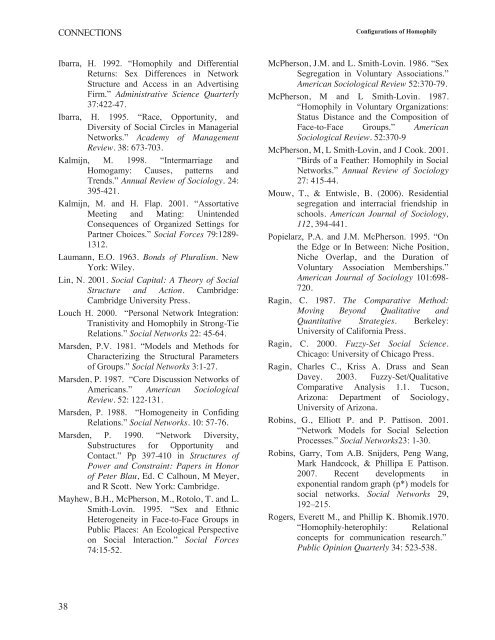CONNECTIONS - INSNA
CONNECTIONS - INSNA
CONNECTIONS - INSNA
Create successful ePaper yourself
Turn your PDF publications into a flip-book with our unique Google optimized e-Paper software.
<strong>CONNECTIONS</strong><br />
Configurations of Homophily<br />
Ibarra, H. 1992. “Homophily and Differential<br />
Returns: Sex Differences in Network<br />
Structure and Access in an Advertising<br />
Firm.” Administrative Science Quarterly<br />
37:422-47.<br />
Ibarra, H. 1995. “Race, Opportunity, and<br />
Diversity of Social Circles in Managerial<br />
Networks.” Academy of Management<br />
Review. 38: 673-703.<br />
Kalmijn, M. 1998. “Intermarriage and<br />
Homogamy: Causes, patterns and<br />
Trends.” Annual Review of Sociology. 24:<br />
395-421.<br />
Kalmijn, M. and H. Flap. 2001. “Assortative<br />
Meeting and Mating: Unintended<br />
Consequences of Organized Settings for<br />
Partner Choices.” Social Forces 79:1289-<br />
1312.<br />
Laumann, E.O. 1963. Bonds of Pluralism. New<br />
York: Wiley.<br />
Lin, N. 2001. Social Capital: A Theory of Social<br />
Structure and Action. Cambridge:<br />
Cambridge University Press.<br />
Louch H. 2000. “Personal Network Integration:<br />
Tranistivity and Homophily in Strong-Tie<br />
Relations.” Social Networks 22: 45-64.<br />
Marsden, P.V. 1981. “Models and Methods for<br />
Characterizing the Structural Parameters<br />
of Groups.” Social Networks 3:1-27.<br />
Marsden, P. 1987. “Core Discussion Networks of<br />
Americans.” American Sociological<br />
Review. 52: 122-131.<br />
Marsden, P. 1988. “Homogeneity in Confiding<br />
Relations.” Social Networks. 10: 57-76.<br />
Marsden, P. 1990. “Network Diversity,<br />
Substructures for Opportunity and<br />
Contact.” Pp 397-410 in Structures of<br />
Power and Constraint: Papers in Honor<br />
of Peter Blau, Ed. C Calhoun, M Meyer,<br />
and R Scott. New York: Cambridge.<br />
Mayhew, B.H., McPherson, M., Rotolo, T. and L.<br />
Smith-Lovin. 1995. “Sex and Ethnic<br />
Heterogeneity in Face-to-Face Groups in<br />
Public Places: An Ecological Perspective<br />
on Social Interaction.” Social Forces<br />
74:15-52.<br />
McPherson, J.M. and L. Smith-Lovin. 1986. “Sex<br />
Segregation in Voluntary Associations.”<br />
American Sociological Review 52:370-79.<br />
McPherson, M and L Smith-Lovin. 1987.<br />
“Homophily in Voluntary Organizations:<br />
Status Distance and the Composition of<br />
Face-to-Face Groups.” American<br />
Sociological Review. 52:370-9<br />
McPherson, M, L Smith-Lovin, and J Cook. 2001.<br />
“Birds of a Feather: Homophily in Social<br />
Networks.” Annual Review of Sociology<br />
27: 415-44.<br />
Mouw, T., & Entwisle, B. (2006). Residential<br />
segregation and interracial friendship in<br />
schools. American Journal of Sociology,<br />
112, 394-441.<br />
Popielarz, P.A. and J.M. McPherson. 1995. “On<br />
the Edge or In Between: Niche Position,<br />
Niche Overlap, and the Duration of<br />
Voluntary Association Memberships.”<br />
American Journal of Sociology 101:698-<br />
720.<br />
Ragin, C. 1987. The Comparative Method:<br />
Moving Beyond Qualitative and<br />
Quantitative Strategies. Berkeley:<br />
University of California Press.<br />
Ragin, C. 2000. Fuzzy-Set Social Science.<br />
Chicago: University of Chicago Press.<br />
Ragin, Charles C., Kriss A. Drass and Sean<br />
Davey. 2003. Fuzzy-Set/Qualitative<br />
Comparative Analysis 1.1. Tucson,<br />
Arizona: Department of Sociology,<br />
University of Arizona.<br />
Robins, G., Elliott P. and P. Pattison. 2001.<br />
“Network Models for Social Selection<br />
Processes.” Social Networks23: 1-30.<br />
Robins, Garry, Tom A.B. Snijders, Peng Wang,<br />
Mark Handcock, & Phillipa E Pattison.<br />
2007. Recent developments in<br />
exponential random graph (p*) models for<br />
social networks. Social Networks 29,<br />
192–215.<br />
Rogers, Everett M., and Phillip K. Bhomik.1970.<br />
“Homophily-heterophily: Relational<br />
concepts for communication research.”<br />
Public Opinion Quarterly 34: 523-538.<br />
38
















